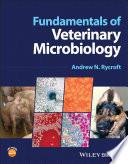Fundamentals of Veterinary Microbiology

Čtenářům se dostává do rukou kompaktní a přístupná příručka zkoumající současné poznatky o běžných bakteriálních a mykotických patogenech zvířat.
V publikaci se spojují znalosti a porozumění bakteriálních patogenů zvířat od příznaků onemocnění, diagnostických metod až po molekulární základy interakce hostitelských patogenů. Publikace umožňuje čtenáři přístup k důležitým informacím během diagnostiky a léčby klinicky relevantním způsobem. Je vhodným společníkem pro studium mikrobiologie i pro profesionální použití. Autor se zaměřuje na klinicky běžnější onemocnění na obecné a prvoreferenční úrovni.
První část je rozdělena do tří sekcí a pokrývá základy bakteriální mikrobiologie, jako je struktura, růst a genetika. Druhá část zkoumá běžně se vyskytující bakteriální patogeny s důrazem na současné chápání buněčné a molekulární podstaty infekce a imunity. Třetí část zkoumá současný stav znalostí o mykotických infekcích, které se podílejí na infekci zvířat.
Specifická témata obsažená v publikaci zahrnují:
Výživa, sterilizace a dezinfekce bakterií, bakteriální geny a přenos genů, patogenita a reakce hostitele a očkování.
Antimikrobiální látky (účinek, dynamika a rezistence), typizace a identifikace patogenů, plísně jako původci chorob, Salmonella a E. coli v chorobách zvířat a veřejného zdraví.
Patogeny přenášené vektory, jako jsou Borrelie, patogeny endogenního původu, jako jsou Clostridium a Pasteurella a ty, které se mohou široce šířit, jako jsou Leptospira, Mycobacterium a Chlamydia.
Mykotické patogeny způsobující povrchové, subkutánní a systémové mykózy.
Jsou základním zdrojem pro studenty veterinární medicíny, veterinární sestry a veterinární lékaře po celém světě, což jim umožňuje rychle si vytvořit základ znalostí o bakteriálních patogenech na základě jasného porozumění získaného ze studií v posledních desetiletích.
Autor: Andrew N. Rycroft
| Nakladatel | Wiley-Blackwell |
|---|---|
| ISBN | 9780470659472 |
| Vydání | I. vydání 2024 |
| Vazba | brožovaná |
| Počet stran | 240 |
A compact and accessible guidebook exploring current understanding of common bacterial and fungal pathogens of animals.
Fundamentals of Veterinary Microbiology brings together knowledge and understanding of the bacterial pathogens of animals from disease signs and diagnostic methods to the molecular basis of the host pathogen interaction. A small but focused book, it enables the reader to access important information during diagnosis and treatment in a clinically relevant way. Suitable as a companion for study on the subject and for professional use, the author focuses on the more clinically common diseases at the general and first-referral level.
Divided into three sections, the first covers the basics of bacterial microbiology such as structure, growth and genetics. The second examines the commonly encountered bacterial pathogens, with emphasis on current understanding of the cellular and molecular basis of infection and immunity. The third section explores the current state of knowledge of those fungi involved in infection of animals.
Specific topics covered in Fundamentals of Veterinary Microbiology include:
Nutrition, sterilization, and disinfection of bacteria, bacterial genes and gene transfer, pathogenicity and host response, and vaccination
Antimicrobials (action, dynamics, and resistance), typing and identification of pathogens, fungi as agents of disease, Salmonella and E. coli in animal disease and public health
Pathogens transmitted by vectors such as Borrelia, those of endogenous origin such as Clostridium and Pasteurella and those able to spread widely such as Leptospira, Mycobacterium and Chlamydia
Fungal pathogens causing superficial, subcutaneous and systemic mycoses
Fundamentals of Veterinary Microbiology is an essential resource for veterinary students, veterinary nurses, and veterinary practitioners worldwide, allowing them to quickly establish a foundation of knowledge of bacterial pathogens based on clear understanding gained from studies over recent decades.
ABOUT THE AUTHOR
Andrew N. Rycroft, BSc (Hons), PhD, FRCPath, is Emeritus Professor of Clinical and Veterinary Microbiology at the Royal Veterinary College, University of London, in the UK. He spent 9 years as lecturer at Glasgow University Veterinary School before moving to the RVC in 1992. He is a fellow of the Royal College of Pathologists.
| Preface | xvii |
| About the Companion Website | xix |
| 1 The Bacterial Cell | 1 |
| 2 Metabolism, Growth and Culture of Bacteria | 9 |
| 3 Sterilisation and Disinfection | 15 |
| 4 Bacterial Genes and Gene Transfer | 23 |
| 5 Bacterial Pathogenicity | 29 |
| 6 Bacterial Veterinary Vaccines | 39 |
| 7 Antimicrobials: Action, Dynamics and Resistance | 43 |
| 8 Bacterial Typing | 51 |
| 9 Salmonella | 55 |
| 10 Escherichia coli – An Intestinal Pathogen | 63 |
| 11 Escherichia coli as an Extraintestinal Pathogen | 69 |
| 12 Campylobacter – Hyperendemic on the Farm | 75 |
| 13 Leptospira – Using Urine to Spread | 81 |
| 14 Lyme Disease – Ticks and Dogs | 87 |
| 15 Brachyspira | 91 |
| 16 Pasteurella | 93 |
| 17 Pseudomonas and Burkholderia | 97 |
| 18 Bordetella | 101 |
| 19 Delicate Gram-negative Bacteria | 105 |
| 20 Mannheimia, Actinobacillus and Other Pasteurellaceae | 111 |
| 21 Chlamydia – A Stealthy Pathogen | 117 |
| 22 Bovine Tuberculosis and Johne's Disease | 121 |
| 23 Bacillus anthracis | 129 |
| 24 Clostridium | 133 |
| 25 Staphylococcus – Skin and Soft Tissue Infection | 143 |
| 26 Streptococcus | 149 |
| 27 Nocardia, Actinomyces and Dermatophilus – The Filamentous Pathogens | 155 |
| 28 Prescottella (Rhodococcus) equi | 159 |
| 29 Corynebacterium – CLA | 163 |
| 30 Listeria – Growing in the Fridge | 165 |
| 31 Erysipelothrix and Trueperella | 169 |
| 32 Mycoplasma – Cell-associated Pathogens | 173 |
| 33 Rickettsia – Arthropod Vector-borne Pathogens | 179 |
| 34 Fungi as Agents of Disease | 183 |
| 35 Aspergillus – Strength in Numbers | 187 |
| 36 Dermatophytes – Keratinolytic Fungi | 191 |
| 37 Yeasts: Malassezia, Candida and Cryptococcus | 195 |
| 38 Dimorphic Fungal Infections | 199 |
| Index | 205 |